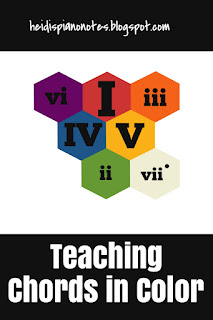Playing music from a lead sheet opens up a new world of possibilities so that you can make familiar tunes have their own special flare.
Free Christmas Lead Sheets
These free Christmas lead sheets from Michael Kravchuk allow pianists to practice chords or prep to accompany a Christmas sing a long. Starting with the key of C is definitely easier for a beginner pianist, but playing in other keys can sometimes make it easier to sing along. Here are a few familiar favorites I like to star with but there are over 30 to choose from on MichaelKravchuk.com with options to select from multiple keys for each song.
Jingle Bells - 5 finger melody (I, IV,V)
Silent Night - slower chord changes (I, IV,V)
O Christmas Tree- slower chord changes (I, IV,V)
Away in a Manger-Mueller (I, IV,V, ii)
Jolly Old Saint Nicolas- (I, IV & V, vi, iii) chord changes only at beginning of measures
We Wish You a Merry Christmas (I, IV & V, vi, iii, ii)
Angels We Have Heard on High - (I, IV & V, vi, iii) frequent chord changes
Joy to the World - frequent chord changes and inversions
Carol of the Bells - (I, IV,V, ii) many inverted chords
What is a Lead Sheet?
A lead sheet usually includes the lyrics to a song with some chord symbols written above. Instead of having to stick to a fully written out song, when you play from a lead sheet you can choose your own style of accompaniment while playing the melody or even just play the chords as you sing the melody.
The letter names written above the melody indicate the chord root (bottom note). For example "C" means play the notes of a C major chord. A lowercase "m" indicates the chord is minor. You you can choose the order and style and difficulty of the chords from the options below.
Lead sheets with roman numeral chord symbols (I, IV, V, vi, etc.) instead of chord letter names can be transposed into several keys.
You can play along with a YouTube video in the same key using these Easy Christmas Chord Lead Sheets.
Step by Step Lead Sheet Playing
Level 1 Play Only Left Hand Root Note
Sing the melody as you play just the root notes with your left hand. Choose the octave you prefer. For example does High G or Low G sound better? Which is easiest to play?
Level 2- Left Hand Root Position Chord
Play the chords in root position (stacked up like a snowman) as you move your hand like a cookie cutter to the different chords.
Level 3- Left Hand Chord Inversion
Jumping around between root chords can be tricky! If you change the order of the notes (invert) it can make it easier to switch between chords. CEG to GBD is a big leap, but if you play CEG and BDG instead you can feel the stretch down without having to look at your fingers.
Level 4-Left Hand Root Notes + Right Hand Melody
Learn the right hand melody choosing fingering for legato phrases. Than add the left hand root notes.
Level 5-Left Hand Chord Inversions + RH Melody
Play the right hand melody along with left hand chord progressions. You can substitute minor chords for major chords you are more familiar with playing.
Experiment with chords that share some of the same chord tones. For example in the key of C, the d minor (ii) chord D-F-A could be replaced with the more familiar F Major (IV) chord F-A-C because both include F and A.
- Substitutes for Red (I) are Purple (vi) and Orange (iii)
- Substitutes for Blue (IV) is (ii) Green and Purple (vi)
- Substitute for Yellow (V) is Orange (iii) or (vii) or (V7)
Level 6 -Left Hand Chord Variations + RH Melody
Instead of playing just blocked chords, choose a different style that matches the mood of the song.
- A lively song like Jingle Bells might sound good with marching style chords.
- Playing broken or arpeggiated chords with calm songs like O Holy Night creates a more dance like, lullaby feel.
- Rocking open 5ths or repeated bass notes create a more pop or rock mood with upbeat songs.
Level 7- Improvisation
Let your imagination transform the piece into your own variation. What if you....
Swap the melody and chords by playing melody in left hand and chords in right hand.
Change the octave to higher or lower for some parts of the song
Add an intro or outro
Create a medley by merging ideas from 2 different songs together.
Explore more ways to change up the piece with variation cards.


No comments:
Post a Comment